The Best Keto Bread Without Eggs
This recipe may contain Amazon or other affiliate links. As an Amazon Associate I earn from qualifying purchases.
This egg-free keto bread recipe is the answer to the questions I regularly get about how to make a keto bread recipe with no eggs and that tastes like traditional wheat bread!
And it makes, quite frankly, the best recipe for keto bread.
It takes only 20 minutes to make, and it is ideal for your keto sandwiches with only 3.6 grams of net carbs per slice!

Calling all the bread lovers with this new low-carb coconut flour bread recipe! Wondering how to make low-carb bread without eggs? I hear you.
There is nothing worse than an eggy taste in bread.
So this coconut flour bread recipe comes to the rescue! A dense, soft keto and eggless bread recipe, similar to my best keto bread, but with coconut flour!
What Is Keto Bread?
Keto bread is low-carb, diabetes-friendly bread made with low-carb flour and usually requires many eggs.
Therefore, most keto bread recipes have an eggy taste that many don’t appreciate.
The reason why keto bread uses so many eggs is simple. Low-carb flours are high in fibers, wheat-free, and starch-free. Starch and wheat usually bind ingredients in regular bread, forming a bulk.
To hold ingredients together, people often use eggs in keto bread recipes to create a bulky, soft, fluffy bread loaf. However, an egg is not the only way of making good keto bread loaves.
I am so excited to show you how you can actually make keto bread eggless!
Why You’ll Love This Recipe
This recipe for keto bread is amazing because it’s:
- Egg-Free
- Gluten-Free
- Low-Carb
- Keto
- Dairy-Free
- Vegan
- Paleo
- Only 15 Minutes Of Prep
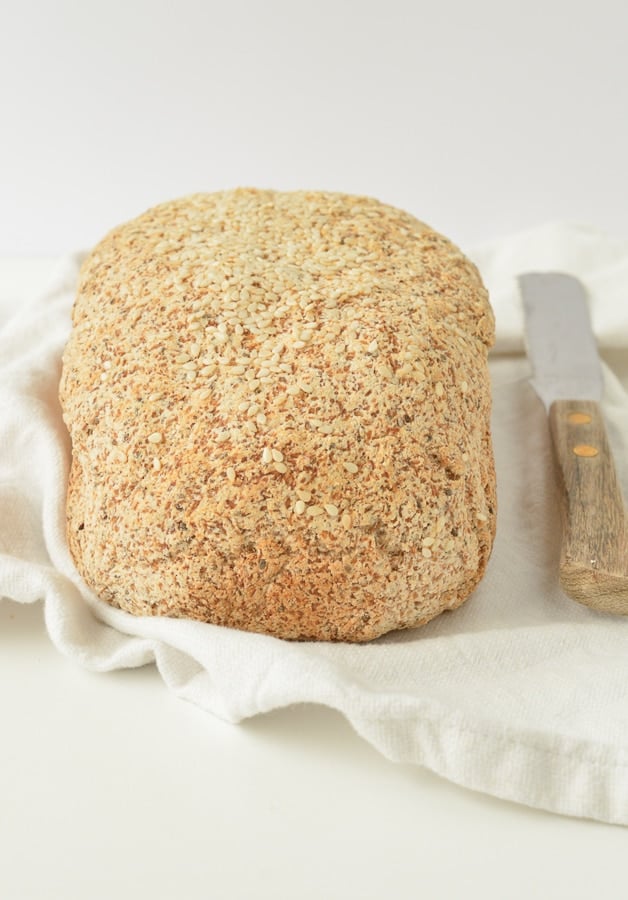
How To Make A Keto Bread Loaf Without Eggs
As mentioned before, eggs are used in keto bread recipes to hold low-carb flour together.
But, I am here going to show you that this is not the only way to make keto bread.
The trick is to use a combo of natural high-fiber ingredients that will act like eggs in your recipe.
This coconut-flour-based recipe uses a combo of whole psyllium husk and chia seed that when in contact with lukewarm water, holds low-carb flour as eggs would do.
It results in the best keto bread recipe, soft and dense with no eggy taste.
Ingredients
There are only 6 ingredients required for this recipe:
- Coconut Flour – Coconut flour is a healthy, tasty keto-flour option that comes loaded with fiber and nutrients. It’s highly water absorbent and is essential for this keto bread’s texture.
- Almond Flour – Almond flour is my favorite low-carb flour because it’s about 7 times lower in carbs than all-purpose flour while behaving very similarly in baking recipes. Pick ultra-fine almond flour for the best results.
- Psyllium Husk – Psyllium husk is as close to pure fiber as it gets. It contains about 70% fiber and is a great way to replace eggs. It is, however, not a straight replacer for eggs, so recipes need to be purpose-made with husk. This recipe requires whole psyllium husk, not ground.
- Chia Seeds – You can use either white chia or black chia seeds.
- Baking Powder – this contributes to rising the bread dough.
- Apple Cider Vinegar
Serving Keto Bread
This keto bread recipe is delicious to make:
- Breakfast toast – add mashed avocado on top or homemade chia seed jam or cream cheese and keto fruits like raspberries if you don’t have time to make jam.
- Sandwiches – use two slices of this keto bread stuffed with butter, cheese, cured meat, or crunchy raw keto vegetables. You can also toast the sandwich in a sandwich press and butter the outside slices for a crispy sandwich.
- French toast – dip the bread slices in beaten eggs and almond milk, then fry in butter. Serve with a pinch of ground cinnamon and sugar-free crystal sweetener.

Frequently Asked Questions
It’s not difficult to make keto bread without eggs. However, if you are new to the keto diet, there are a few things you must keep in mind.
1. Stick to the ingredients list – if the recipe calls for fine almond flour, don’t replace it with a coarser almond meal. Same for the whole psyllium husk, don’t use Metamucil fiber supplements in my recipes. This is not the same product as whole psyllium husk fiber. Metamucil is a husk powder that is not suitable for baking keto bread. It will turn food dry, purple, or blue.
2. Weigh ingredients – keto baking uses high-fiber flours. Too much or too little of it, even in tiny amounts, will impact the bread texture a lot. Therefore, cups are not precise enough to achieve the best result every time. In fact, when you measure ingredients in cups, it’s easy to add a little bit too much of one flour (it would dry out your bread) or miss some flour resulting in moist undercooked bread.
3. Practice. Keto baking is different from what you used for baking before. You need practice and time to learn how to bake with these new flours. Repeat the recipe, be precise. You will learn each time.
4. Find your favorite flour brands. Yes, all flour brands are different. For example, some almond flours are finer than others. Experiment with different brands until you find the one that gives the best outcomes for your keto bread. Also, remember that the most expensive brands are not necessarily the best ones. I personally use my supermarket brands to make this recipe at a very low price.
The slices of this keto bread are soft, with a compact, dense crumb.
This is a gluten-free, egg-free keto bread, so it will not rise much, and will not be that fluffy or airy because there are no eggs in the eggless keto bread.
It can be slightly moist if you did not weigh the ingredients properly or if you used coarse flour.
But this can be fixed by toasting your bread slices! The taste is very similar to a whole-wheat artisan bread with no eggy taste.
That is probably the question I get the most about egg-free keto baking. Experience shows me that doughy bread is always due to one of 3 things:
1. You didn’t weigh your ingredients – the wrong flour/water ratio makes the dough too moist. Weigh your ingredients, don’t use cups!
2. Your husk or almond flour is too coarse and doesn’t absorb moisture. Change brand, experiment until you find your favorite one.
3. Your oven temperature is wrong/too cold. Old ovens or conventional modes are less powerful than the fan mode. You can try to increase your oven temperature by 35°F (20°C), so bake this bread at 400°F (200°C) if your oven doesn’t cook well enough.

More Vegan Keto Bread Recipes
There are many ways to make egg-free keto bread, depending on which low-carb flour you want to use.
If you love egg-free keto bread, check my other keto bread recipes:
More Low Carb Bread Recipes
Some of my best keto recipes are bread recipes! Check out the Sweet As Honey Keto Bread below!
Did You Like This Recipe?
Leave a comment below or head to our Facebook page for tips, our Instagram page for inspiration, our Pinterest for saving recipes, and Flipboard to get all the new ones!

Best Keto Bread Recipe Without Eggs
Ingredients
Dry ingredients
- 4.3 oz Coconut Flour scoop and level method (or 1 cup)
- 2.1 oz Almond Flour (or 1/2 cup)
- 0.95 oz Whole Psyllium Husk (or 1/3 cup)
- 0.91 oz Chia Seeds (or 2 tablespoons)
- 2 teaspoons Baking Powder or 1 teaspoon baking soda
- ½ teaspoon Salt
Liquid ingredients
- 2 ¼ cups Lukewarm Water 18.9 fl.oz
- 2 teaspoons Apple Cider Vinegar
Instructions
- Preheat oven 350°F (180°C), fan mode works the best and faster. Otherwise, use conventional baking mode. Line a 9-inch x 5-inch loaf pan with parchment paper. Set aside.
- Measure all your ingredients carefully before you start. I highly recommend weighing your ingredients in grams or oz for precision rather than cups. If you use cups, make sure they are packed, leveled up using flour with no lumps.
- In a large mixing bowl, whisk together all the dry ingredients.
- Add apple cider vinegar and lukewarm water (think hot bath temperature, cold water won't activate the fiber in the flour, and the ingredients won't bind)0
- Combine with a spoon at first. It will be very liquid and will dry out as you go. After 30 seconds, the dough is moist, not liquid, and slightly crumbles apart. Knead the dough, press/squeeze with your hands for at least 1 minute, or until you can form a ball.
- Form a dough ball and set it aside on the benchtop for 10 minutes to let the fiber absorb all the water and hold the ingredients together.
- Now the dough should be soft, elastic, and slightly moist but should hold perfectly together. Shape a cylinder, bread loaf shape. Don't press the dough too much. It's a gluten-free loaf, it won't rise, and the shape you give will be the shape you get. If you press too much, it will be very dense, doughy.
- Another option is to shape 14 small buns to make bread rolls. If so, bake on a cookie sheet covered with parchment paper. It will bake faster – only 35 minutes on the bottom rack.
- Place the loaf onto the prepared loaf pan covered with parchment paper.
- If cracks appear on top, wet your fingers with water and massage the top of the bread to fix cracks. Sprinkle 1 tablespoon of sesame seeds or poppy seeds to decorate (optional).
- Bake on the bottom rack of the oven (first rack from the bottom) for 45 minutes then switch to the middle rack for 15 extra minutes. You can add a piece of foil paper on top of the loaf if the color gets too brown.
- Insert a skewer in the middle of the bread to check the texture. It should come out dry with no or very few crumbs on it.
- Remove from the oven and cool on a rack for 4 hours or overnight before slicing.
How to serve
- The texture is dense, soft, and can be slightly packed or moist at the bottom if you press the dough too much or your husk is too thick (change brand next time for a better result!). If so, toast the bread slices to add some crispiness and dry out. Otherwise, serve directly as a sandwich bread with butter, avocado, spinach, lettuce, chicken, or cheese.
Storage
- Store up to 3 days in the pantry or fridge. Slice when needed to keep the bread moist.
- Slice into 14 slices and freeze the slices in a zip lock bag.
- Defrost the day before and toast before using it.
Notes
- Bread is undercooked/too doughy: read the blog post above to see why this happens.
Tools
Getting Started What Is Keto? Macro Calculator Sweetener Converter Intermittent Fasting Keto Fruits Keto Vegetables Keto Flours Fighting Keto Flu Healthy SweetenersWant My Kitchen Equipment?
Nutrition
Disclaimer
The recipes, instructions, and articles on this website should not be taken or used as medical advice. You must consult with your doctor before starting on a keto or low-carb diet. The nutritional data provided on Sweetashoney is to be used as indicative only.
The nutrition data is calculated using WP Recipe Maker. Net Carbs is calculated by removing the fiber and some sweeteners from the total Carbohydrates. As an example, a recipe with 10 grams of Carbs per 100 grams that contains 3 grams of erythritol and 5 grams of fiber will have a net carbs content of 2 grams. Some sweeteners are excluded because they are not metabolized.
You should always calculate the nutritional data yourself instead of relying on Sweetashoney's data. Sweetashoney and its recipes and articles are not intended to cure, prevent, diagnose, or treat any disease. Sweetashoney cannot be liable for adverse reactions or any other outcome resulting from the use of recipes or advice found on the Website.

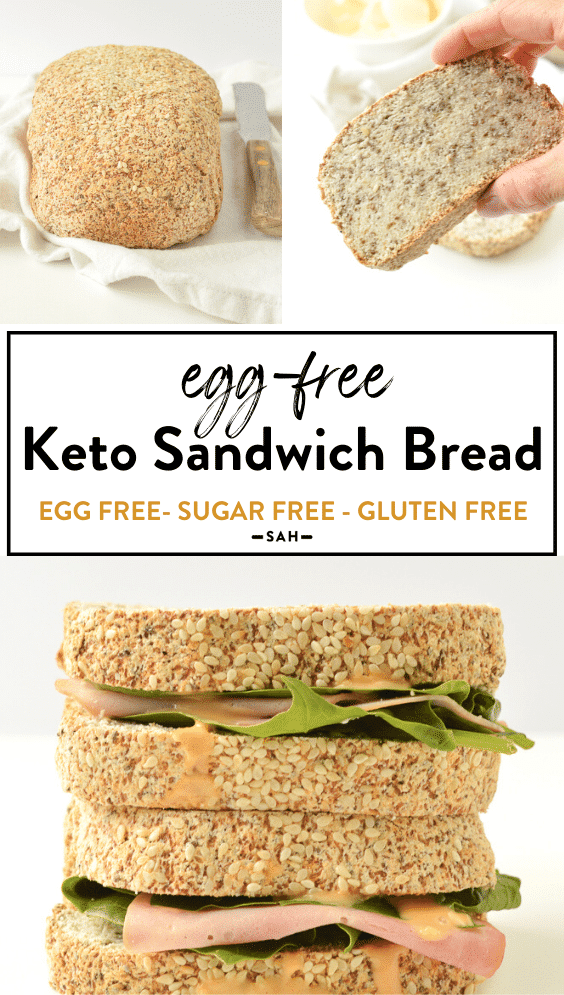
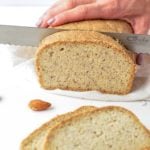


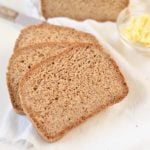





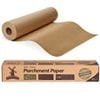
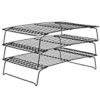
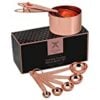



Share this post!
If you enjoyed this post, share it with your close ones!
Leave a comment
Hi,
Can you replace the almond flour with something else? Unfortunately, I have an almond allergy. Maybe with ground hazelnuts? I would love to test the bread because I am looking for alternatives to Diabetes 2
I too have an almond allergy so after experimenting a bit I found that replacing the amount of almond flour with half cashew flour and half quinoa flour gives the best results. The recipes here are the best I have found anywhere. Thank you!
Thanks for the tips ! I am so happy you found my blog, Enjoy the recipes around here. XOXO Carine
Sure, sunflower seed flour or ground hazelnuts (very thin not coarse!) will be ok in same amount. Enjoy! XOXO Carine
2.1 cups of almond flour – should it be 2.1 ounces?
Yes 2.1 oz or 1/2 cup sorry for that.
I live at high altitude in Denver, CO (5,280 feet). How do we make corrections for altitude with low carb breads such as this? Normally, we would increase the oven temperature by 15-25 degrees, decrease the baking time by 20-30%, increase flour by 1 tbsp per 1,500 ft, decrease sugar by 1 tbsp per cup, increase liquids by 6-8 tbsp, decrease baking powder by 50%, and/or decrease yeast by 25%. Since this particular recipe is so different, I’m not sure what adjustments to make for my altitude issues.
I am very sorry but I have no idea! I wouldn’t change anything in the ingredients, simply bake until set. Hope it goes well, XOXO Carine